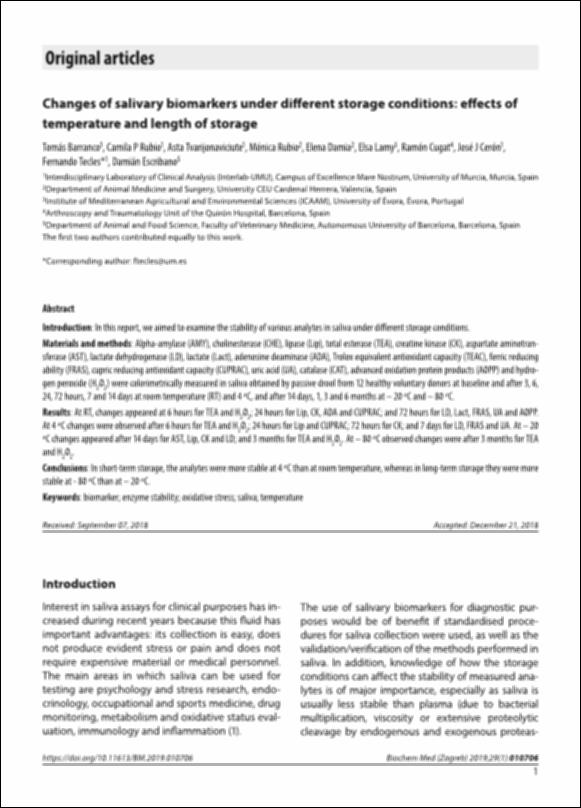Please use this identifier to cite or link to this item:
http://hdl.handle.net/10637/10760Changes of salivary biomarkers under different storage conditions : peffects of temperature and length of storage
| Title: | Changes of salivary biomarkers under different storage conditions : peffects of temperature and length of storage |
| Authors : | Barranco Benacloch, Tomás Peres Rubio, Camila Tvarijonaviciute, Asta Rubio Zaragoza, Mónica. Damiá Giménez, Elena Lamy, Elsa Cugat Bertomeu, Ramón Cerón Madrigal, José Joaquín Tecles, Fernando Escribano Tortosa, Damián |
| Keywords: | Estrés oxidativo.; Oxidative stress.; Marcadores bioquímicos.; Saliva - Análisis.; Biochemical markers.; Saliva - Analysis.; Enzimas - Análisis.; Enzymes - Analysis. |
| Publisher: | Croatian Society of Medical Biochemistry. |
| Citation: | Barranco, T., Rubio, CP., Tvarijonaviciute, A., Rubio, M., Damia, E., Lamy, E. et al. (2019). Changes of salivary biomarkers under different storage conditions : peffects of temperature and length of storage. Biochemia Medica, vol. 29, n. 1 (15 feb.), art. 010706. DOI: https://doi.org/10.11613/BM.2019.010706 |
| Abstract: | Introduction: In this report, we aimed to examine the stability of various analytes in saliva under different storage conditions. Materials and methods: Alpha-amylase (AMY), cholinesterase (CHE), lipase (Lip), total esterase (TEA), creatine kinase (CK), aspartate aminotransferase (AST), lactate dehydrogenase (LD), lactate (Lact), adenosine deaminase (ADA), Trolox equivalent antioxidant capacity (TEAC), ferric reducing ability (FRAS), cupric reducing antioxidant capacity (CUPRAC), uric acid (UA), catalase (CAT), advanced oxidation protein products (AOPP) and hydrogen peroxide (H2O2) were colorimetrically measured in saliva obtained by passive drool from 12 healthy voluntary donors at baseline and after 3, 6, 24, 72 hours, 7 and 14 days at room temperature (RT) and 4 ºC, and after 14 days, 1, 3 and 6 months at – 20 ºC and – 80 ºC. Results: At RT, changes appeared at 6 hours for TEA and H2O2; 24 hours for Lip, CK, ADA and CUPRAC; and 72 hours for LD, Lact, FRAS, UA and AOPP. At 4 ºC changes were observed after 6 hours for TEA and H2O2; 24 hours for Lip and CUPRAC; 72 hours for CK; and 7 days for LD, FRAS and UA. At – 20ºC changes appeared after 14 days for AST, Lip, CK and LD; and 3 months for TEA and H2O2. At – 80 ºC observed changes were after 3 months for TEA and H2O2. Conclusions: In short-term storage, the analytes were more stable at 4 ºC than at room temperature, whereas in long-term storage they were more stable at - 80 ºC than at – 20 ºC. |
| Description: | Este artículo se ha publicado de forma definitiva en: https://www.biochemia-medica.com/en/journal/29/1/10.11613/BM.2019.010706 En este artículo también participan: Camila P Rubio, Asta Tvarijonaviciute, Mónica Rubio, Elena Damia, Elsa Lamy, Ramón Cugat, José J. Cerón, Fernando Tecles y Damián Escribano. |
| URI: | http://hdl.handle.net/10637/10760 |
| Rights : | http://creativecommons.org/licenses/by/4.0/deed.es |
| ISSN: | 1330-0962 1846-7482 (Electrónico) |
| Issue Date: | 15-Feb-2019 |
| Center : | Universidad Cardenal Herrera-CEU |
| Appears in Collections: | Dpto. Medicina y Cirugía Animal |
Items in DSpace are protected by copyright, with all rights reserved, unless otherwise indicated.


